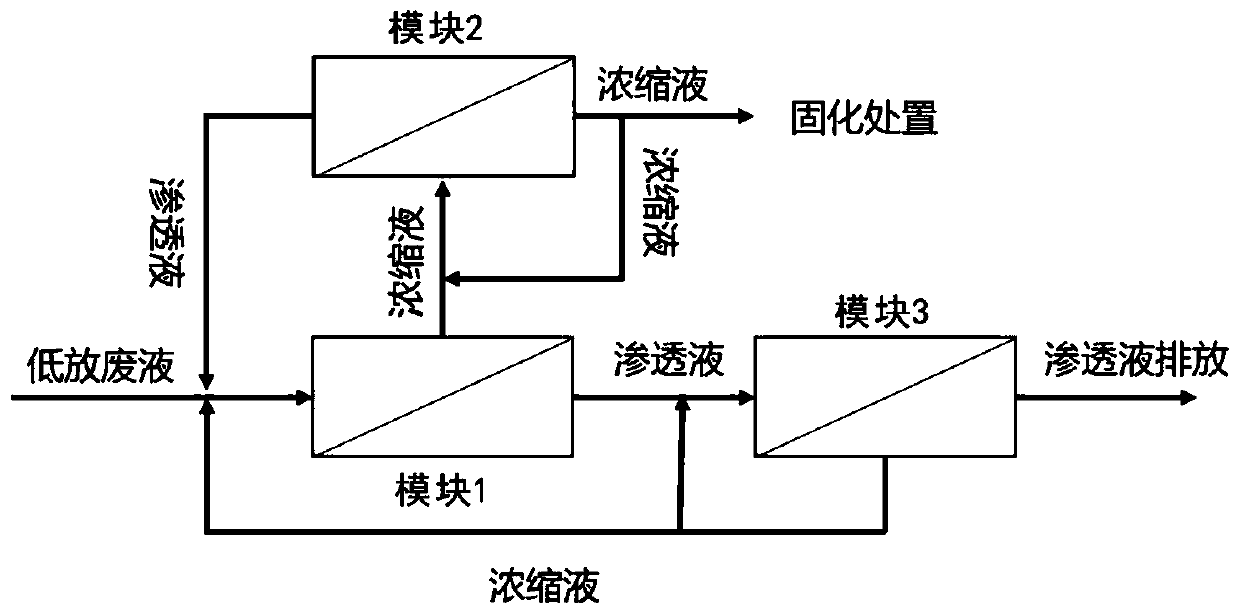Method and system for separating and concentrating radionuclides in radioactive waste liquid by utilizing reverse osmosis membrane
A technology for radionuclides and radioactive waste liquids, applied in semi-permeable membrane separation, radioactive purification, reverse osmosis, etc. The effect of reducing the amount of waste, reducing the amount of secondary waste, and improving the separation efficiency
- Summary
- Abstract
- Description
- Claims
- Application Information
AI Technical Summary
Problems solved by technology
Method used
Image
Examples
Embodiment 1
[0081] Soak the polyamide membrane in 25% isopropanol solution for 20 minutes, then wash it with deionized water 6 times, 30 minutes each time, store it in deionized water at 4°C; first cover it with carbodiimide solution for 10 minutes , then add N-hydroxysuccinimide solution, pour out the waste liquid after covering for 50 minutes, wash the reverse osmosis membrane with deionized water twice; then use 5% polyethyleneimine with a molecular weight of 600 The solution was covered for 12 hours, and light-shielding treatment was carried out during the process, and then the waste liquid was poured out, and the membrane was washed twice with deionized water to obtain a modified polyamide membrane material.
[0082] The modified membrane material was dried, and the Zeta potential on the surface of the membrane changed from negative to positive through analysis and testing. Then put the modified membrane material into the membrane test device for testing, the concentration of nuclide...
Embodiment 2
[0085] Soak the polyamide membrane in 25% isopropanol solution for 20 minutes, then wash it with deionized water 6 times, 30 minutes each time, store it in deionized water at 4°C; first cover it with carbodiimide solution for 10 minutes , then add N-hydroxysuccinimide solution, pour out the waste liquid after covering for 50 minutes, wash the reverse osmosis membrane with deionized water twice; then use 5% polyethyleneimine with a molecular weight of 1800 The solution was covered for 12 hours, and light-shielding treatment was carried out during the process, and then the waste liquid was poured out, and the membrane was washed twice with deionized water to obtain a modified polyamide membrane material.
[0086] The modified membrane material was dried, and the Zeta potential on the surface of the membrane changed from negative to positive through analysis and testing. Then put the modified membrane material into the membrane test device for testing, the concentration of nuclid...
Embodiment 3
[0089] Soak the polyamide membrane in 25% isopropanol solution for 20 minutes, then wash it with deionized water 6 times, 30 minutes each time, store it in deionized water at 4°C; first cover it with carbodiimide solution for 10 minutes , then add N-hydroxysuccinimide solution, pour out the waste liquid after covering for 50 minutes, wash the reverse osmosis membrane with deionized water twice; then use 5% polyethyleneimine with a molecular weight of 10000 The solution was covered for 12 hours, and light-shielding treatment was carried out during the process, and then the waste liquid was poured out, and the membrane was washed twice with deionized water to obtain a modified polyamide membrane material.
[0090] The modified membrane material was dried, and the Zeta potential on the surface of the membrane changed from negative to positive through analysis and testing. Then put the modified membrane material into the membrane test device for testing, the concentration of nucli...
PUM
| Property | Measurement | Unit |
|---|---|---|
| molecular weight | aaaaa | aaaaa |
| molecular weight | aaaaa | aaaaa |
| molecular weight | aaaaa | aaaaa |
Abstract
Description
Claims
Application Information
 Login to View More
Login to View More - R&D
- Intellectual Property
- Life Sciences
- Materials
- Tech Scout
- Unparalleled Data Quality
- Higher Quality Content
- 60% Fewer Hallucinations
Browse by: Latest US Patents, China's latest patents, Technical Efficacy Thesaurus, Application Domain, Technology Topic, Popular Technical Reports.
© 2025 PatSnap. All rights reserved.Legal|Privacy policy|Modern Slavery Act Transparency Statement|Sitemap|About US| Contact US: help@patsnap.com

